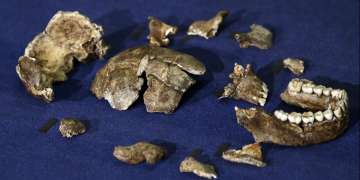Some of the first animals on the Earth were connected by networks of thread-like filaments which may have been used for nutrition, communication or reproduction, the earliest evidence yet found of life being connected in this way, according to a study. Scientists from the Universities of Cambridge and Oxford in the UK discovered the fossilised threads -- some as long as four metres -- connecting organisms known as rangeomorphs, which dominated the Earth's oceans half a billion years ago.
The study, published in the journal Current Biology, found these filament networks in seven species across nearly 40 different fossil sites in Newfoundland, Canada. Towards the end of the Ediacaran period, between 571 and 541 million years ago, the first diverse communities of large and complex organisms began to appear. Prior to this, almost all life on the Earth had been microscopic in size, the researchers said.
Fern-like rangeomorphs were some of the most successful life forms during this period, growing up to two metres in height and colonising large areas of the sea floor, they said. The researchers explained that rangeomorphs may have been some of the first animals to exist, although their strange anatomies have puzzled palaeontologists for years. These organisms do not appear to have had mouths, organs or means of moving, according to the researchers.
One suggestion is that they absorbed nutrients from the water around them, they said. Since rangeomorphs could not move and are preserved where they lived, it is possible to analyse whole populations from the fossil record. Earlier studies of rangeomorphs have looked at how these organisms managed to reproduce and be so successful in their time. "These organisms seem to have been able to quickly colonise the sea floor, and we often see one dominant species on these fossil beds," said Alex Liu from Cambridge's Department of Earth Sciences.
"How this happens ecologically has been a longstanding question -- these filaments may explain how they were able to do that," Liu said. Most of the filaments were between two and 40 centimetres in length, although some were as long as four metres. Since they are so thin, the filaments are only visible in places where the fossil preservation is exceptionally good, which is one of the reasons they were not identified sooner.
The fossils for this study were found on five sites in eastern Newfoundland, one of the world's richest sources of Ediacaran fossils, the researchers said. It's possible that the filaments were used as a form of clonal reproduction, like modern strawberries, they said. Since the organisms in the network were the same size, the filaments may have had other functions, according to the researchers.
ALSO READ | NASA's Curiosity Rover captures high-resolution images of Mars
ALSO READ | NASA's next Mars rover officially named 'Perseverance'; middle school student earns honour
